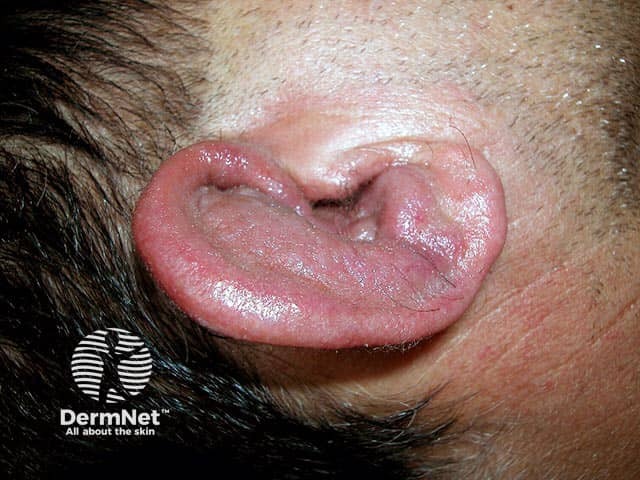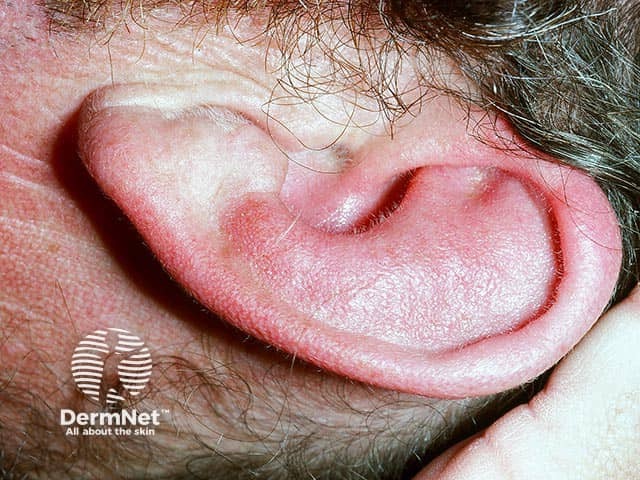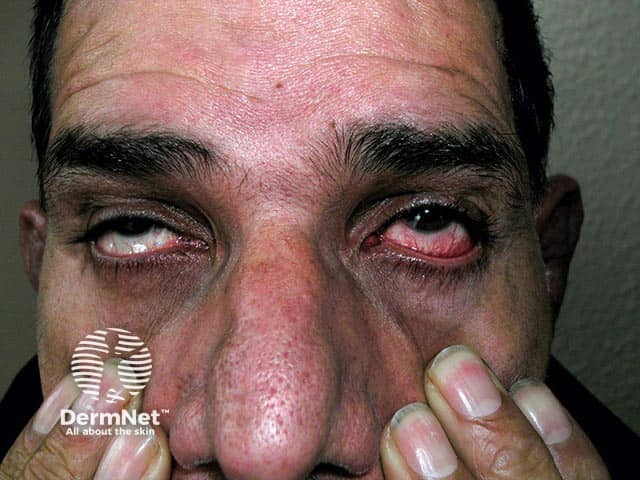Main menu
Common skin conditions

NEWS
Join DermNet PRO
Read more
Quick links
Relapsing polychondritis — extra information
Relapsing polychondritis
Last reviewed: June 2023
Authors: Dr Hamish Wu, Medical Registrar, Auckland; and Honorary Associate Professor Paul Jarrett, Dermatologist, Middlemore Hospital and The University of Auckland, New Zealand (2023)
Previous contributors: Dr Mark Duffill, Dermatologist (2008)
Reviewing dermatologist: Dr Ian Coulson
Edited by the DermNet content department
Introduction Demographics Causes Clinical features Variation in skin types Complications Diagnosis Differential diagnoses Treatment Outcome
What is relapsing polychondritis?
Relapsing polychondritis is a rare autoimmune disorder characterised by recurrent episodes of inflammation and destruction of cartilaginous tissues.
Relapsing polychondritis most commonly affects the cartilage in the ears, nose, trachea, and joints, causing pain, swelling, and stiffness. The eyes, heart, and blood vessels are less commonly affected but can result in serious complications.
While there is no clear aetiology or specific diagnostic test for relapsing polychondritis, early recognition and treatment improve prognosis.

A swollen red inflammed pinna due to polychondritis - both ears were affected. Note sparing of the non-cartilaginous lobe (RP-patient1)

Swelling and erythema of the upper cartilaginous part of the helix with sparing of the non-cartilaginous lobe

Red eyes (which can be due to scleritis, episcleritis, conjunctivitis, and iritis) seen as part of the presentation of relapsing polychondritis (RP-patient1)

Collapsed cartilage in polychondritis
Xray of auricular relapsing polychondritis
See more images of relapsing polychondritis
Who gets relapsing polychondritis?
- The incidence is estimated to be 3.5 cases per million people per year.
- It can manifest at any age, but is most prevalent between the ages of 40 and 60.
- There is no gender or ethnic predilection.
What causes relapsing polychondritis?
- There is no known aetiology.
- A combination of autoimmune and genetic factors results in connective tissue damage.
- The autoimmunity observed involves both T and B lymphocytes.
- T lymphocytes produce proinflammatory cytokines, including tumour necrosis factor-alpha (TNFα) and interleukin 1 (IL-1), which cause inflammation and destruction of connective tissue.
- B lymphocytes release auto-antibodies that target chondrocytes and connective tissue.
- Polychondritis of the ear and nose can be a feature of VEXAS syndrome, an acquired X-linked autoinflammatory syndrome seen in middle-aged men.
What are the clinical features of relapsing polychondritis?
Relapsing polychondritis most commonly presents as inflammation of the cartilage of the ears (auricular chondritis) and nose (nasal chondritis).
Cutaneous features
- Auricular chondritis affects up to 90% of patients, presenting with redness, swelling, and tenderness of the pinna or ear canal, classically sparing the ear lobes. It is often bilateral. This can resemble infectious cellulitis which is usually unilateral. Chronic disease may result in drooping or cauliflower ears due to softening of the cartilage.
- Nasal chondritis affects up to 50% of patients and may result in saddle nose deformity.
- Other cutaneous features (none of which are pathognomonic) include oral aphthosis, painful nodules or papules, sterile pustules, livedo reticularis, vesicular or bullous lesions, ulcers, vasculitis, and alopecia.
- Raynaud phenomenon can occur.
Non-cutaneous features
- Arthritis (affects 30–50% of patients) in a single or multiple joints. The cartilaginous joints of the ribs are most commonly affected.
- Ocular inflammation (affects 25–30% of patients): eye redness, pain, or blurring of the vision.
- Involvement of tracheal and bronchial cartilage (affects 20–30%) can result in obstructive symptoms (hoarseness, cough, and shortness of breath), airway collapse, and lung infections. Loss of rigidity of the bronchial cartilage can result in airway collapse during inspiration.
- Cardiovascular involvement (affects 5–10% of patients) can result in aortic or mitral valve disease or aortic aneurysms.
- Other neurological, nephrological, and auditory sequelae may occur.
See images of relapsing polychondritis
How do clinical features vary in differing types of skin?
Erythema of inflamed cartilage may be less evident in darker skin phototypes.
What are the complications of relapsing polychondritis?
- Respiratory — airway obstruction, chronic bronchitis.
- Cardiovascular — valvulopathies (particularly the aortic valve), aortopathies.
- Ocular — scleritis, episcleritis, keratitis, uveitis.
- Auditory — hearing loss, vertigo, tinnitus.
- Neurological — damage to cartilaginous structures in the spine can result in spinal cord compression.
- Musculoskeletal — arthritis, joint deformities.
- Renal — glomerulonephritis, kidney failure.
How is relapsing polychondritis diagnosed?
Diagnosis can be challenging as relapsing polychondritis mimics other conditions. Diagnosis is often determined using a combination of clinical features, imaging, and laboratory results.
- Clinical features include redness and other signs of inflammation in the cartilage of various parts of the body.
- Blood tests:
- Autoantibodies: anti-collagen type II antibodies and anti-cartilage oligomeric matrix protein (COMP) antibodies are found in up to 50% and 40% of RP patients, respectively. Anti-matrilin-1 is less prevalent. However, there is no specific antibody to the disease and the presence of these antibodies does not necessarily confirm a diagnosis of RP.
- Inflammatory markers: elevated erythrocyte sedimentation rate (ESR) and C-reactive protein (CRP) are common.
- Imaging: MRI or CT evidence of cartilaginous inflammation.
- Tissue biopsy: usually taken from cartilage on the ear or nose.
Diagnostic criteria
The McAdam’s diagnostic criteria require at least 3 of the following (and usually a tissue biopsy consistent with chondritis as well):
- Bilateral auricular chondritis
- Nasal chondritis
- Ocular inflammation
- Respiratory tract chondritis
- Vestibulocochlear dysfunction
- Seronegative inflammatory polyarthritis.
Alternative diagnostic criteria are also specified in the modified (Damiani) criteria; if the above criteria are not satisfied, diagnosis could also be made on the basis of:
- 1 or more clinical findings above with positive histopathological confirmation
- Steroid or dapsone-responsive chondritis at 2 or more different anatomical sites.
What is the differential diagnosis for relapsing polychondritis?
- Systemic lupus erythematosus (SLE)
- Sjögren syndrome
- Vasculitis
- Rheumatoid arthritis
- Polymyalgia rheumatica
- Cartilaginous infection (bacterial, fungal, or viral)
What is the treatment for relapsing polychondritis?
There is no known cure for relapsing polychondritis. Treatment aims to control symptoms and prevent complications.
General measures
- Monitoring for complications and education around this.
Specific measures
- Non-steroidal anti-inflammatory drugs (NSAIDs) for those with auricular or nasal chondritis or arthritis without end-organ damage (unless contraindicated).
- Immunisations to prevent respiratory infections (eg, annual flu vaccination) in those with airway involvement.
- Systemic corticosteroids remain the mainstay of treatment.
Other immunosuppressive agents used include:
- Dapsone
- Colchicine
- Azathioprine
- Methotrexate
- Cyclophosphamide
- Hydroxychloroquine
- Ciclosporin
- Infliximab (see: Tumour necrosis factor inhibitors)
- Berdazimer (currently being investigated in clinical trials).
In severe cases, surgical interventions such as a tracheostomy, nasal septal repair, bronchial segment repair, or cardiac valve replacement may be necessary.
What is the outcome for relapsing polychondritis?
Relapsing polychondritis has a variable prognosis depending on the severity and the degree of organ involvement. Early diagnosis and treatment can improve outcomes and prevent complications.
In general, the mortality rate is believed to be ~5–10%. Respiratory failure is a major cause of death. Patients with cardiovascular or renal dysfunction have poorer outcomes.
Bibliography
- Ernst A, Rafeq S, Boiselle P, et al. Relapsing Polychondritis and Airway Involvement. Chest. 2009;135(4):1024–30. doi: 10.1378/chest.08-1180. Journal
- Chen N, Zheng Y. Characteristics and Clinical Outcomes of 295 Patients With Relapsing Polychondritis. J Rheumatol. 2021;48(12):1876–82. doi: 10.3899/jrheum.210062. Journal
- Rapini RP, Warner NB. Relapsing polychondritis. Clin Dermatol. 2006;24(6):482–5. doi: 10.1016/j.clindermatol.2006.07.018. Journal
- Rednic S, Damian L, Talarico R, et al. Relapsing polychondritis: state of the art on clinical practice guidelines. RMD Open. 2018;4(Suppl 1):e000788. doi: 10.1136/rmdopen-2018-000788. Journal
- Sharma A, Gnanapandithan K, Sharma K, Sharma S. Relapsing polychondritis: a review. Clin Rheumatol. 2013;32(11):1575–83. doi: doi: 10.1007/s10067-013-2328-x. Journal
- Vitale A, Sota J, Rigante D, et al. Relapsing Polychondritis: an Update on Pathogenesis, Clinical Features, Diagnostic Tools, and Therapeutic Perspectives. Curr Rheumatol Rep. 2016;18(1):3. doi: 10.1007/s11926-015-0549-5. Journal
- Zhang L, Yun S, Wu T, et al. Clinical patterns and the evolution of relapsing polychondritis based on organ involvement: a Chinese retrospective cohort study. Orphanet J Rare Dis. 2021;16(1):225. doi: 10.1186/s13023-021-01861-x. Journal
On DermNet
- Relapsing polychondritis images
- Autoimmune diseases in dermatology
- Skin signs of rheumatic disease
- VEXAS syndrome
- Systemic corticosteroids
